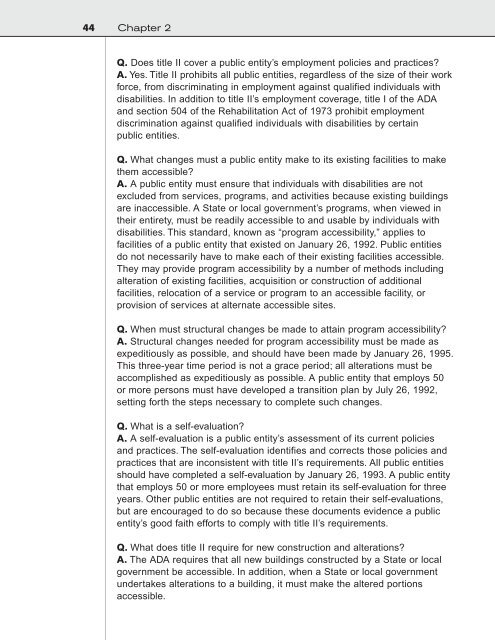Design for Accessibility: A Cultural Administrator's Handbook
Design for Accessibility: A Cultural Administrator's Handbook
Design for Accessibility: A Cultural Administrator's Handbook
You also want an ePaper? Increase the reach of your titles
YUMPU automatically turns print PDFs into web optimized ePapers that Google loves.
44 Chapter 2<br />
Q. Does title II cover a public entity’s employment policies and practices?<br />
A. Yes. Title II prohibits all public entities, regardless of the size of their work<br />
<strong>for</strong>ce, from discriminating in employment against qualified individuals with<br />
disabilities. In addition to title II’s employment coverage, title I of the ADA<br />
and section 504 of the Rehabilitation Act of 1973 prohibit employment<br />
discrimination against qualified individuals with disabilities by certain<br />
public entities.<br />
Q. What changes must a public entity make to its existing facilities to make<br />
them accessible?<br />
A. A public entity must ensure that individuals with disabilities are not<br />
excluded from services, programs, and activities because existing buildings<br />
are inaccessible. A State or local government’s programs, when viewed in<br />
their entirety, must be readily accessible to and usable by individuals with<br />
disabilities. This standard, known as “program accessibility,” applies to<br />
facilities of a public entity that existed on January 26, 1992. Public entities<br />
do not necessarily have to make each of their existing facilities accessible.<br />
They may provide program accessibility by a number of methods including<br />
alteration of existing facilities, acquisition or construction of additional<br />
facilities, relocation of a service or program to an accessible facility, or<br />
provision of services at alternate accessible sites.<br />
Q. When must structural changes be made to attain program accessibility?<br />
A. Structural changes needed <strong>for</strong> program accessibility must be made as<br />
expeditiously as possible, and should have been made by January 26, 1995.<br />
This three-year time period is not a grace period; all alterations must be<br />
accomplished as expeditiously as possible. A public entity that employs 50<br />
or more persons must have developed a transition plan by July 26, 1992,<br />
setting <strong>for</strong>th the steps necessary to complete such changes.<br />
Q. What is a self-evaluation?<br />
A. A self-evaluation is a public entity’s assessment of its current policies<br />
and practices. The self-evaluation identifies and corrects those policies and<br />
practices that are inconsistent with title II’s requirements. All public entities<br />
should have completed a self-evaluation by January 26, 1993. A public entity<br />
that employs 50 or more employees must retain its self-evaluation <strong>for</strong> three<br />
years. Other public entities are not required to retain their self-evaluations,<br />
but are encouraged to do so because these documents evidence a public<br />
entity’s good faith ef<strong>for</strong>ts to comply with title II’s requirements.<br />
Q. What does title II require <strong>for</strong> new construction and alterations?<br />
A. The ADA requires that all new buildings constructed by a State or local<br />
government be accessible. In addition, when a State or local government<br />
undertakes alterations to a building, it must make the altered portions<br />
accessible.


